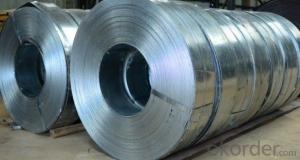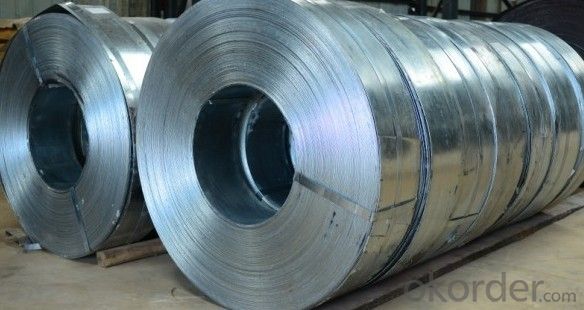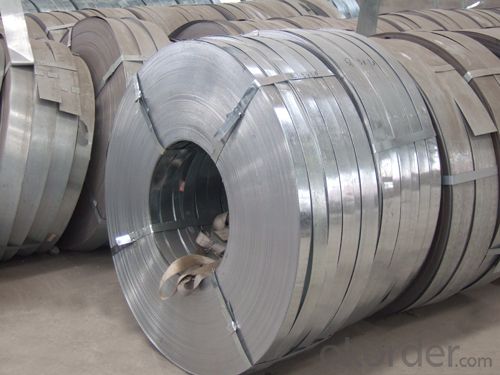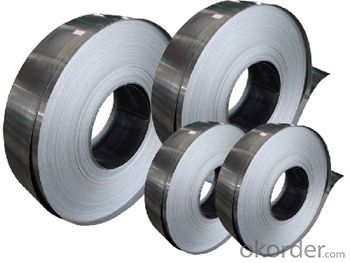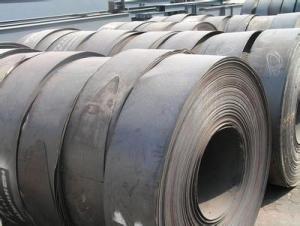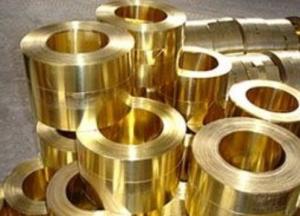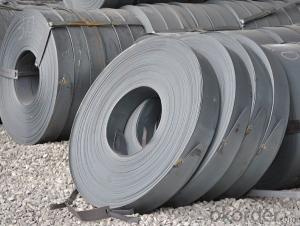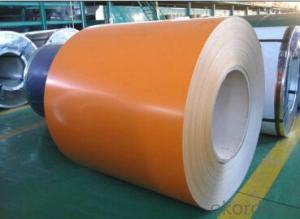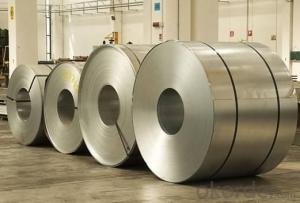Galvanized Steel Strip with High Quality-SGCC 630*0.8mm
- Loading Port:
- China main port
- Payment Terms:
- TT OR LC
- Min Order Qty:
- 50 m.t
- Supply Capability:
- 10000 m.t/month
OKorder Service Pledge
OKorder Financial Service
You Might Also Like
Galvanized Steel Strip with High Quality-SGCC 630*0.8mm
Product Description:
Specifications:
1. Thickness: 0.8mm
2. Width: 630mm
3. Material: SGCC
4. ID: 508mm or 610mm
5. Spangle: Regular spangle or zero spangle
6. others: chromated or no chromated; oiled or no oiled.
Advantages of Galvanized Steel Strip with High Quality-SGCC 630*0.8mm:
1. Uniform coating;
2. Strong adhesion;
3. Strong corrosion resistant ability
Usage of Galvanized Steel Strip with High Quality-SGCC 630*0.8mm:
1. Making pipes, like Greenhouse tubes, drinking water pipe, heating pipe, gas pipe and so on;
2. Used in automobile;
3. Used in construction;
4. Used in agriculture, fishery and so on.
FAQ of Galvanized Steel Strip with High Quality-SGCC 630*0.8mm:
Q1: How soon can we receive the product after purchasement?
A1: Within three days of placing an order, we will begin production. The specific shipping date is dependent upon international and government factors, but is typically one month-two months.
Q2: How do you guarantee the quality of our products?
A2: We have established an advanced quality management system which conducts strict quality tests at every step, from raw materials to the final product. At the same time, we provide extensive follow-up service assurances as required.
Q3: The prices are invoicing on theoritical weight or on actual weight?
A3: We can do it in both manners, according to the customers' request.
Images of Galvanized Steel Strip with High Quality-SGCC 630*0.8mm:
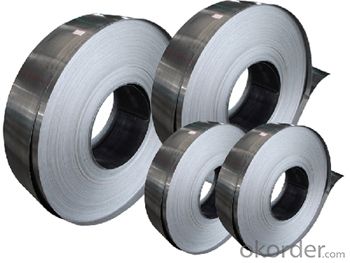
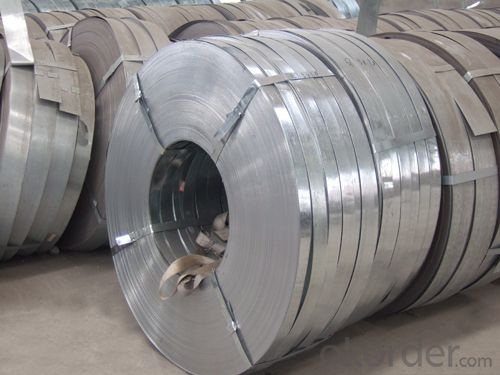
- Q: What are the factors to consider when selecting steel strips for a specific application?
- When selecting steel strips for a specific application, several factors need to be considered. These include the desired mechanical properties such as strength, hardness, and ductility, as well as the required corrosion resistance. Other factors to consider are the dimensions and thickness of the strips, the manufacturing process, and the intended environment and conditions of use. Additionally, cost, availability, and any specific industry standards or certifications may also influence the selection process.
- Q: Can steel strips be used for making electrical terminals?
- Indeed, the utilization of steel strips is feasible for the production of electrical terminals. Steel, being an adaptable substance, possesses commendable conductivity and remarkable strength, rendering it appropriate for a wide range of applications within the electrical sector. The creation of steel terminals can be achieved by shaping steel strips through procedures such as stamping, bending, and welding. These terminals establish a dependable connection for electrical wires and components, guaranteeing the efficient transmission of electrical current. Furthermore, steel strips can undergo plating with substances like tin or nickel to augment their resistance against corrosion and enhance their conductivity. In summary, steel strips present a practical choice for the fabrication of electrical terminals due to their electrical properties, durability, and ease of production.
- Q: How are steel strips inspected for defects?
- Steel strips are inspected for defects using various methods to ensure their quality and integrity. One common method is visual inspection, where trained inspectors visually examine the surface of the steel strips for any visible defects such as cracks, scratches, or deformities. This is often done with the help of magnifying glasses or microscopes to detect even the smallest imperfections. Another method used for defect inspection is magnetic particle testing. In this technique, the steel strips are magnetized, and fine iron particles are applied to the surface. These particles will accumulate at any areas where there are defects, allowing the inspectors to easily identify and locate them. Ultrasonic testing is also employed to inspect steel strips for defects. Ultrasonic waves are directed into the steel, and the reflections or echoes of these waves are analyzed. Any changes or irregularities in the echo pattern can indicate the presence of defects within the steel strips. In addition, eddy current testing is commonly used for defect detection in steel strips. This method involves passing an alternating current through a coil, which creates a magnetic field. When the steel strip is placed near the coil, any defects or variations in the material will cause changes in the eddy currents, which can be detected and analyzed. Furthermore, X-ray or gamma-ray testing may be utilized for defect inspection. These methods involve passing radiation through the steel strips and capturing the resulting image on a film or digital detector. Any defects, such as internal cracks or voids, will appear as dark spots on the image, making them easily identifiable. Overall, steel strips undergo a combination of visual, magnetic particle, ultrasonic, eddy current, and radiographic inspections to ensure that they are free from defects and meet the required quality standards. These rigorous inspection methods help to ensure the reliability and safety of steel strips in various industries.
- Q: What are the different welding techniques used for steel strips?
- There are several welding techniques commonly used for steel strips, including resistance welding, fusion welding, and laser welding. Resistance welding involves passing an electric current through the steel strips to generate heat and create a weld. Fusion welding, on the other hand, involves melting the edges of the steel strips and fusing them together. Laser welding uses a high-powered laser beam to melt and join the steel strips. Each technique has its advantages and is chosen based on factors such as the thickness of the strips, desired strength of the joint, and production requirements.
- Q: How are steel strips used in the production of hinges and hardware?
- Steel strips are an essential component in the production of hinges and hardware due to their durability and strength. These strips are typically made from high-quality steel alloys, which offer excellent resistance to corrosion, wear, and tear. In the manufacturing process, steel strips are cut into specific lengths and widths, depending on the desired size and shape of the hinges or hardware being produced. These strips are then shaped, bent, and formed using various techniques such as stamping, pressing, or rolling. The steel strips are carefully manipulated to create the necessary components of hinges and hardware, such as the hinge leaves, pins, or brackets. These components are then assembled and welded together, ensuring a secure and sturdy connection. The use of steel strips in hinge and hardware production also allows for customization and flexibility in design. Different thicknesses and widths of steel strips can be utilized to meet specific strength and load-bearing requirements. Additionally, the steel can be further treated or coated to enhance its performance, such as through galvanization to provide additional protection against rust and corrosion. Overall, steel strips play a crucial role in the production of hinges and hardware by providing the necessary strength, durability, and versatility required for these components. Their use ensures that hinges and hardware are capable of withstanding the demands of daily use and provide reliable functionality for various applications.
- Q: How do steel strips contribute to the durability of infrastructure?
- Steel strips, also known as steel reinforcement or rebar, play a crucial role in enhancing the durability of infrastructure. These strips are incorporated into various construction elements, such as concrete, to provide additional strength and prevent potential structural failure. One of the key contributions of steel strips to infrastructure durability is their ability to resist tension forces. Concrete is excellent in compression but weak in tension, making it prone to cracking or failure when subjected to excessive loads or environmental conditions. By adding steel strips to concrete elements, the overall structure becomes more resistant to tension, as the strips absorb and distribute the forces, thereby preventing cracks and enhancing its overall durability. Additionally, steel strips also improve the structural stability of infrastructure by reinforcing against bending and shearing forces. In bridges, for example, these strips are often used in the construction of beams and columns, providing strength and preventing excessive deflection or collapse under heavy traffic loads. Similarly, in high-rise buildings, steel strips are used to reinforce columns, walls, and slabs, ensuring the structure can withstand the vertical and lateral loads it may encounter. Furthermore, steel strips contribute to the durability of infrastructure by improving its resistance to corrosion. Steel is naturally susceptible to rust when exposed to moisture and air, which can weaken the structure over time. However, modern steel reinforcement is typically protected with a layer of epoxy coating or embedded within a concrete layer, safeguarding it against corrosion and extending its lifespan. In summary, steel strips significantly enhance the durability of infrastructure by reinforcing against tension, bending, and shearing forces. They prevent cracking, increase structural stability, and improve resistance to corrosion. By incorporating steel strips into construction elements, infrastructure can withstand various external factors, ensuring longevity and safety for years to come.
- Q: How are steel strips processed for sealing?
- Steel strips are processed for sealing through a series of steps which typically include cleaning, coating, and forming. First, the steel strips are thoroughly cleaned to remove any dirt, oil, or other contaminants that may interfere with the sealing process. Then, a coating is applied to the strips, often through methods like galvanizing or electroplating, to provide protection against corrosion and improve their sealing properties. Finally, the strips are formed into the desired shape, such as a gasket or a seal, using techniques like roll forming or stamping, ensuring they meet the specific requirements of the sealing application.
- Q: How do steel strips contribute to reducing greenhouse gas emissions in various applications?
- Steel strips contribute to reducing greenhouse gas emissions in various applications through their energy efficiency, recyclability, and durability. Firstly, steel strips are energy-efficient during their production process. Steel is made from iron ore, which is abundant and readily available. The steel industry has made significant advancements in technology, such as using electric arc furnaces, which require less energy compared to traditional blast furnaces. Additionally, steel manufacturers have implemented measures to improve energy efficiency, such as using waste energy recovery systems. These energy-efficient production methods result in lower greenhouse gas emissions during the steel manufacturing process. Moreover, steel strips are highly recyclable. Unlike many other materials, steel can be recycled repeatedly without losing its inherent properties. Recycling steel requires less energy and resources compared to the production of virgin steel. By using recycled steel strips in various applications, we can significantly reduce the demand for new steel production, thereby reducing greenhouse gas emissions associated with the extraction and processing of raw materials. Furthermore, steel strips offer durability and longevity in various applications. Steel is known for its strength and resistance to wear and tear, making it a preferred choice in construction, automotive, and infrastructure industries. By using steel strips that have a longer lifespan, we can reduce the need for frequent replacements and repairs, resulting in lower emissions throughout the lifecycle of the product. In conclusion, steel strips contribute to reducing greenhouse gas emissions in various applications through their energy efficiency, recyclability, and durability. By utilizing energy-efficient production processes, promoting steel recycling, and leveraging the durability of steel strips, we can mitigate the environmental impact and work towards a more sustainable future.
- Q: What are the film coating options for steel strips?
- There are several film coating options for steel strips, including galvanized coatings, zinc-nickel coatings, organic coatings, and epoxy coatings. Each option provides different levels of corrosion resistance and durability, allowing manufacturers to choose the most suitable coating for their specific application.
- Q: Can steel strips be used for making industrial machinery?
- Yes, steel strips can be used for making industrial machinery. Steel strips are often used in the manufacturing of various components and parts for industrial machinery due to their strength, durability, and resistance to wear and tear. These strips can be formed, cut, and welded into different shapes and sizes to create the necessary components and structures required for industrial machinery.
Send your message to us
Galvanized Steel Strip with High Quality-SGCC 630*0.8mm
- Loading Port:
- China main port
- Payment Terms:
- TT OR LC
- Min Order Qty:
- 50 m.t
- Supply Capability:
- 10000 m.t/month
OKorder Service Pledge
OKorder Financial Service
Similar products
Hot products
Hot Searches
Related keywords
